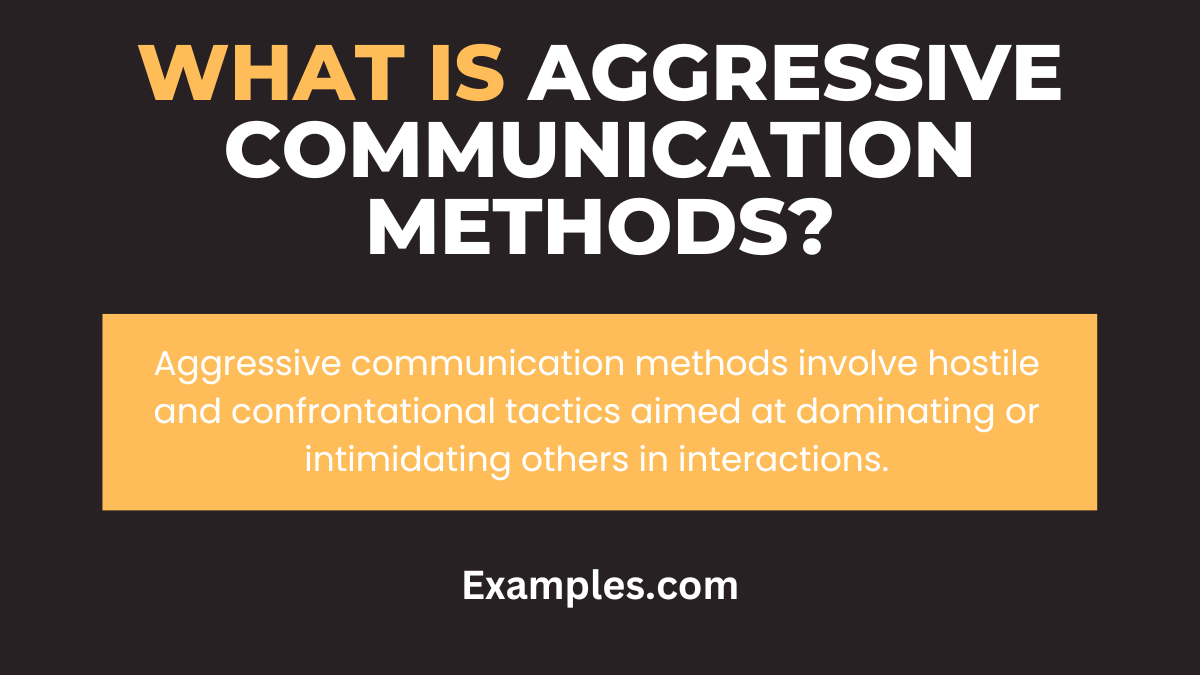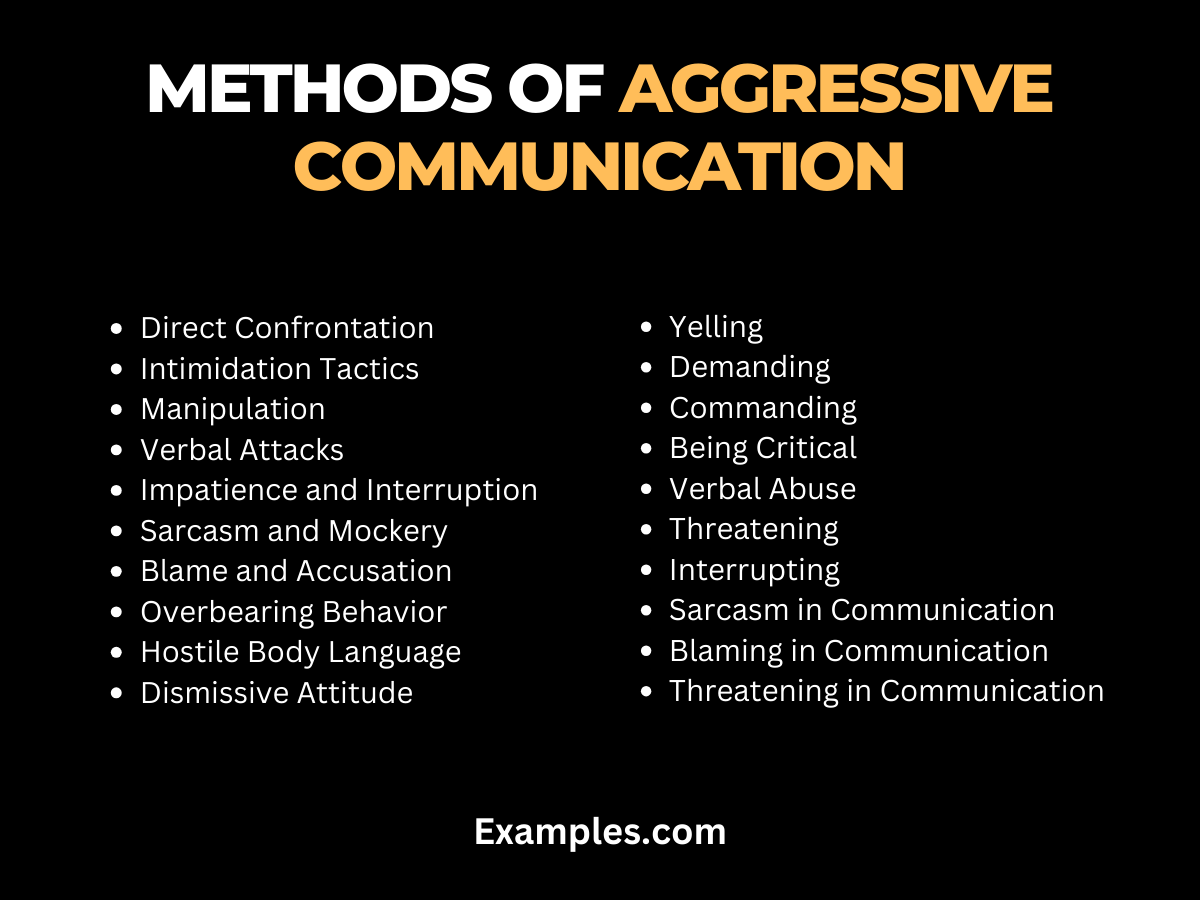19+ Aggressive Communication Methods Examples
Aggressive Communication Methods are powerful tools in the art of assertive dialogue. This comprehensive guide delves into the intricacies of these methods, exploring their effectiveness in various interpersonal scenarios. From the workplace to personal relationships, understanding and utilizing aggressive communication can significantly impact your interaction quality. Learn to navigate these methods with precision and tact, enhancing your communication skills for more dynamic and influential conversations.
What is Aggressive Communication Methods?

Aggressive Communication Methods involve assertive, direct interaction styles. These methods are characterized by a strong, confident approach, often used to express opinions firmly or address conflicts. Understanding these methods is crucial for effective, impactful communication.
20 Methods of Aggressive Communication

Aggressive communication often leads to interpersonal conflicts and strained relationships. This article delves into 20 methods of aggressive communication, highlighting how they manifest in various settings. From verbal aggression to hostile body language, each method is illustrated with practical examples, showcasing the detrimental impact of such communication styles. Understanding these methods is crucial for recognizing and addressing aggressive behavior in personal and professional environments.
- Direct Confrontation: This method involves openly and hostilely challenging someone, often with blunt language and a confrontational attitude, as seen in the phrase, “You’re wrong, and here’s why!”
- Intimidation Tactics: This style uses threatening language to dominate and control others, creating a sense of fear to ensure compliance, exemplified by statements like “Do this, or else!”
- Manipulation: Involves subtly twisting words or situations to one’s advantage, often making the other person feel obligated or guilty, as in “I know you’ll do this, because you owe me.”
- Verbal Attacks: Characterized by direct insults or belittlement, this method aims to demean or degrade someone openly, such as saying, “You’re incapable of doing this right.”
- Impatience and Interruption: This reflects a lack of respect for others’ opinions, where one person doesn’t allow others to speak and imposes their view, like “Stop talking; I know better!”
- Sarcasm and Mockery: Utilizes sarcastic remarks to demean or ridicule others, often in a passive-aggressive manner, seen in phrases like “Oh, like you could do any better!”
- Blame and Accusation: Involves unfairly shifting responsibility and blame onto others, avoiding self-accountability, typified by statements such as “This is all your fault!”
- Overbearing Behavior: This method entails dominating conversations and decisions with an attitude of superiority, often expressed as “It’s my way or the highway!”
- Hostile Body Language: Involves using non-verbal cues like aggressive gestures or intimidating stares to convey aggression and exert control.
- Dismissive Attitude: Characterized by ignoring or trivializing others’ opinions or thoughts, often leading to the belittlement of others’ contributions, as in “Your idea doesn’t matter.”
- Yelling: Involves raising one’s voice to overpower or intimidate others in a conversation, exemplified by “Listen to me right now!”

- Demanding: This method entails forceful insistence, often without considering others’ capacity or willingness, as in “I need this done immediately!”
- Commanding: Involves issuing orders without consideration for others’ feelings or input, often in a dictatorial manner, like “Do this right now!”
- Being Critical: This reflects a habit of constantly finding fault in others, often leading to a negative environment, exemplified by “You never do anything right.”
- Being Verbally Abusive: Involves using harsh, often cruel words intended to hurt or demean someone, as in “You’re worthless!”
- Threatening: Entails imposing fear to manipulate or control someone’s actions or decisions, like “Do this, or you’ll regret it.”
- Interrupting: This method involves cutting someone off to impose one’s views, showing a lack of respect for the speaker, as seen in “Stop, I’m talking now!”

- Sarcasm in Communication: Utilizes biting sarcasm to undermine or belittle someone, often in a passive-aggressive manner, like “Sure, as if you’re the expert!”
- Blaming in Communication: Persistently blames others for problems or issues, avoiding personal accountability, as in “You always mess things up!”
- Threatening in Communication: Involves subtly or overtly using threats during conversations to intimidate or control, exemplified by “You better watch your back.”
Aggressive Communication Methods at Workplace
- Public Criticism: Publicly reprimanding employees, often in front of their peers, which can create a hostile work environment.
- Intimidating Body Language: Using physical presence, like standing too close or towering over someone, to assert dominance.
- Overbearing Directives: Issuing orders without considering employees’ opinions or feelings.
- Verbal Outbursts: Raising voice or using harsh language during discussions or meetings.
- Non-Constructive Feedback: Giving feedback that demoralizes rather than helps improve performance.
Aggressive Communication Methods in Business
- High-Pressure Sales Tactics: Pressuring clients or customers into making decisions quickly without giving them time to consider.
- Dominating Business Meetings: Overpowering others’ voices in meetings, not allowing for a collaborative discussion.
- Aggressive Email Communication: Sending emails with demanding language or a confrontational tone.
- Public Blame: Assigning blame to individuals or teams publicly for failures or mistakes.
- Ruthless Negotiation Tactics: Employing harsh or unfair tactics to force agreement in business deals.
Aggressive communication methods is essential in fostering healthy interpersonal interactions. This article has shed light on various examples of such behavior, emphasizing the importance of respectful and constructive communication. Recognizing and addressing aggression is a step towards more positive and effective communication in personal relationships, the workplace, and social settings. Building a culture of respect and empathy is key for better human connections.



